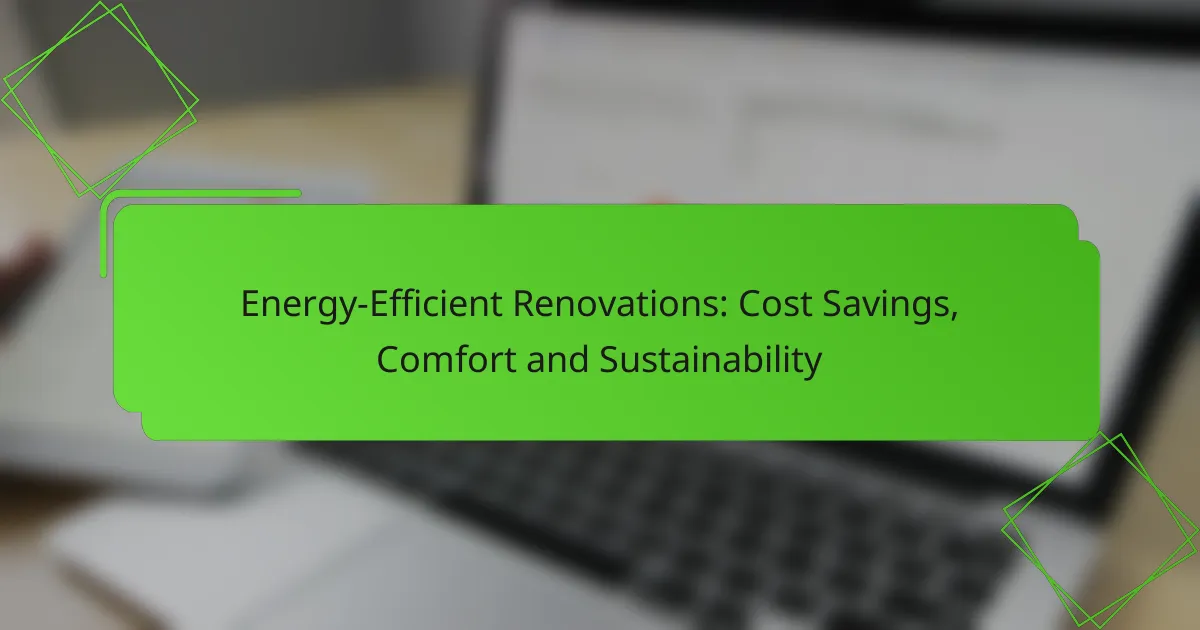Eco-friendly materials are designed to minimize environmental impact throughout their lifecycle, from production to disposal. By choosing these sustainable options, individuals and businesses can reduce waste, conserve resources, and promote a healthier planet. The benefits of using eco-friendly materials include improved health, enhanced brand reputation, and potential long-term cost savings. Sourcing these materials effectively involves identifying local suppliers and prioritizing sustainably sourced, recycled, or biodegradable options.

What are eco-friendly materials?
Eco-friendly materials are substances that have a minimal impact on the environment throughout their lifecycle, from production to disposal. These materials are designed to reduce waste, conserve resources, and promote sustainability.
Biodegradable plastics
Biodegradable plastics are made from natural materials that can decompose over time, reducing landfill waste. They break down through the action of microorganisms, which makes them a more sustainable alternative to conventional plastics.
When sourcing biodegradable plastics, look for certifications such as ASTM D6400 or EN 13432, which indicate compliance with international standards for compostability. Common applications include packaging, utensils, and bags.
Recycled metals
Recycled metals, such as aluminum and steel, are obtained from post-consumer products and industrial scrap. Using recycled metals conserves natural resources and requires less energy compared to producing new metals from ore.
Consider the recycling rates in your area when sourcing recycled metals. For example, aluminum can be recycled indefinitely without losing quality, making it a highly sustainable choice for various applications, including construction and automotive parts.
Organic cotton
Organic cotton is grown without synthetic pesticides or fertilizers, promoting healthier ecosystems and reducing chemical runoff. It is often certified by organizations like the Global Organic Textile Standard (GOTS), ensuring adherence to environmental and social criteria.
When purchasing organic cotton products, look for labels that guarantee organic certification. This material is commonly used in clothing, home textiles, and personal care items, providing a sustainable alternative to conventional cotton.
Bamboo products
Bamboo products are made from the fast-growing bamboo plant, which requires minimal water and no pesticides. Bamboo is naturally antibacterial and biodegradable, making it a popular choice for various applications, including kitchenware and textiles.
When sourcing bamboo products, ensure they are sustainably harvested and processed without harmful chemicals. Look for certifications like FSC (Forest Stewardship Council) to verify responsible sourcing practices.
Hemp-based materials
Hemp-based materials are derived from the hemp plant, known for its durability and low environmental impact. Hemp grows quickly and requires little water, making it a sustainable alternative for textiles, paper, and building materials.
When considering hemp products, check for certifications that confirm organic farming practices. Hemp textiles are increasingly used in clothing, accessories, and home goods, offering a strong and eco-friendly option.

What are the benefits of using eco-friendly materials?
Using eco-friendly materials offers numerous advantages, including reduced environmental harm, improved health for users, enhanced brand reputation, and potential cost savings over time. These benefits make eco-friendly options increasingly appealing for businesses and consumers alike.
Reduced environmental impact
Eco-friendly materials are designed to minimize their ecological footprint. They often come from renewable resources, require less energy to produce, and generate less waste compared to conventional materials. For example, bamboo is a rapidly renewable resource that can be harvested without damaging the environment.
Choosing sustainable materials can significantly lower greenhouse gas emissions and reduce pollution. This shift not only benefits the planet but can also help companies comply with environmental regulations and standards, such as ISO 14001.
Improved health and safety
Many eco-friendly materials are free from harmful chemicals and toxins, which can lead to better indoor air quality and overall health. For instance, natural paints and finishes contain fewer volatile organic compounds (VOCs), reducing the risk of respiratory issues and allergies.
By opting for safer materials, businesses can create healthier environments for employees and customers. This proactive approach can also reduce liability risks associated with health-related claims linked to hazardous materials.
Enhanced brand reputation
Utilizing eco-friendly materials can significantly boost a brand’s image. Consumers are increasingly drawn to companies that prioritize sustainability, leading to greater customer loyalty and trust. A commitment to eco-friendly practices can differentiate a brand in a competitive market.
Brands that effectively communicate their sustainable initiatives often see increased engagement on social media and positive media coverage. This enhanced reputation can translate into higher sales and a more dedicated customer base.
Cost savings over time
While eco-friendly materials may have higher upfront costs, they often lead to long-term savings. For example, energy-efficient materials can reduce utility bills significantly over time. Investing in sustainable options can also decrease waste disposal costs and improve resource efficiency.
Moreover, many governments offer incentives for businesses that adopt sustainable practices, such as tax breaks or grants. These financial benefits can further offset initial investments in eco-friendly materials, making them a smart choice for the future.

How to source eco-friendly materials in Ireland?
Sourcing eco-friendly materials in Ireland involves identifying local suppliers, utilizing online marketplaces, and understanding relevant certifications. Prioritize materials that are sustainably sourced, recycled, or biodegradable to minimize environmental impact.
Local suppliers in Dublin
Dublin hosts several local suppliers specializing in eco-friendly materials. Look for businesses that offer reclaimed wood, organic textiles, and sustainable packaging options. Visiting local markets or trade shows can also provide opportunities to connect with suppliers directly.
Some notable suppliers include The Green Shop and EcoCem, which focus on sustainable construction materials and eco-conscious home goods. Engaging with these suppliers can help ensure that your materials meet local environmental standards.
Online marketplaces for sustainable goods
Online marketplaces provide a convenient way to access a variety of eco-friendly materials. Websites like Etsy and EcoVessel offer products from independent sellers who prioritize sustainability. These platforms often feature detailed descriptions of the materials used, helping you make informed choices.
Additionally, consider using local Irish platforms such as BuyIrish and GreenShop, which focus on promoting sustainable products made in Ireland. This not only supports local businesses but also reduces carbon footprints associated with shipping.
Certifications to look for
When sourcing eco-friendly materials, certifications can help verify a product’s sustainability claims. Look for labels such as FSC (Forest Stewardship Council) for wood products, GOTS (Global Organic Textile Standard) for textiles, and Cradle to Cradle for various materials.
These certifications indicate adherence to strict environmental and social standards. Familiarizing yourself with these labels can guide your purchasing decisions and ensure that the materials you choose align with your sustainability goals.

What criteria should be used to select eco-friendly materials?
To select eco-friendly materials, consider their environmental impact throughout their lifecycle, including sourcing, production, use, and disposal. Prioritizing materials that minimize harm to the ecosystem and promote sustainability is essential for responsible choices.
Material lifecycle assessment
A material lifecycle assessment (LCA) evaluates the environmental effects of a material from extraction to disposal. This process helps identify stages where improvements can be made, such as reducing energy consumption during production or enhancing recyclability at the end of life.
When conducting an LCA, focus on key indicators like carbon footprint, water usage, and waste generation. For example, materials with lower carbon emissions during production and higher rates of recyclability are often more sustainable choices.
Supplier sustainability practices
Supplier sustainability practices refer to the methods and policies that manufacturers implement to ensure their operations are environmentally friendly. Assessing these practices is crucial for ensuring that the materials you choose are sourced responsibly.
Look for suppliers who adhere to recognized sustainability standards, such as ISO 14001, and those who provide transparency about their sourcing and production processes. Engaging with suppliers that prioritize renewable resources and ethical labor practices can significantly enhance the sustainability of your materials.

How do eco-friendly materials compare to traditional materials?
Eco-friendly materials often have a lower environmental impact compared to traditional materials, which can lead to more sustainable construction and manufacturing practices. While they may differ in durability, cost, and performance, understanding these comparisons helps in making informed choices for various applications.
Durability differences
Eco-friendly materials can vary widely in durability compared to traditional options. For instance, bamboo is known for its strength and resilience, often outperforming some hardwoods, while recycled plastics may not withstand extreme weather as well as virgin materials. It’s essential to evaluate the specific eco-friendly material’s properties based on the intended use.
In many cases, eco-friendly materials are designed to be sustainable, which can sometimes lead to trade-offs in longevity. For example, natural fibers like hemp may have a shorter lifespan than synthetic alternatives but offer better biodegradability.
Cost comparison
Generally, eco-friendly materials can be more expensive than traditional materials due to the sourcing and processing methods involved. For instance, sustainably harvested wood may cost 10-30% more than conventionally sourced timber. However, the long-term savings from energy efficiency and reduced waste can offset initial costs.
It’s also worth noting that prices can vary by region. In areas with strong green building incentives, such as certain European countries, eco-friendly materials may be more competitively priced due to subsidies or tax breaks.
Performance in various applications
Performance of eco-friendly materials can differ significantly based on their application. For example, recycled concrete can be used effectively in construction, providing structural integrity while reducing landfill waste. However, some eco-friendly insulation materials may not perform as well in extreme temperatures compared to traditional options.
When selecting materials, consider the specific requirements of your project. For high-performance needs, such as in commercial buildings, it may be necessary to balance eco-friendliness with performance metrics like thermal resistance or moisture control.

What are the emerging trends in eco-friendly materials?
Emerging trends in eco-friendly materials focus on sustainability, innovation, and reduced environmental impact. These materials are increasingly being used across various industries, driven by consumer demand for greener options and regulatory pressures to minimize waste.
Innovations in biodegradable options
Biodegradable materials are gaining traction as they break down naturally, reducing landfill waste. Innovations include plant-based plastics, which decompose more quickly than traditional plastics, and new formulations of paper products that enhance durability while remaining eco-friendly.
Examples of biodegradable options include polylactic acid (PLA) made from corn starch and polyhydroxyalkanoates (PHA) produced by microbial fermentation. These materials can be used in packaging, utensils, and even textiles, providing versatile solutions for various applications.
When considering biodegradable options, it’s essential to check for certifications such as ASTM D6400 or EN 13432, which ensure that materials meet specific compostability standards. This helps consumers and businesses make informed choices about the sustainability of their products.



